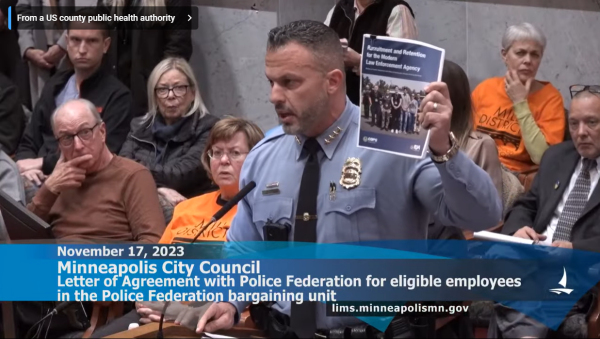On Nov. 17, the Minneapolis City Council struck down a $15 million plan to increase the Minneapolis Police Department’s staff through retention and recruitment incentives for the second time. Once again, the city’s leadership is at a loss to fix its police department, which has been marked by tragedy and violence.
“Today we didn’t get what we were looking for. And to those officers and to those community members that bear the consequences of that, I apologize. We’re not quitting,” Minneapolis Mayor Jacob Frey said after the plan was rejected.
Frey and Minneapolis Police Chief Brian O’Hara announced on Nov. 10 that the city and the Police Officers Federation of Minneapolis had reached an agreement on a plan to address declining police force numbers. The multimillion-dollar investment proposal included an $18,000 officer retention bonus over two-and-a-half years, while newly hired officers would receive a $15,000 recruitment bonus over three years.

O’Hara expressed the need to implement the plan: “This department continues to bleed people, and we need to stop that and stop that urgently.”
According to the Star Tribune’s September 2023 report, MPD currently retains 585 sworn officers–though this number varies, with others putting the estimate at 573 or 579. The Star Tribune found that Minneapolis’ officer-to-population ratio, at 1.4, falls well below the national average of 2.4 officers per 1,000 residents.
“Since 2021, 71% of [MPD’s] workforce has left,” Chief Human Resources Officer Nikki Odom presented to the City Council on Nov. 17. She explained that MPD is currently 38% vacant, and 522 officers have “separated” from MPD since 2020.
In June 2022, the dispute was brought to the Minnesota Supreme Court: eight Minneapolis residents petitioned the city in 2020 to force MPD to adhere to the city charter’s minimum employee requirement of 731 officers. The Supreme Court ruled that the Mayor and the City Council have a “clear legal duty to employ at least 731 officers.”
The staffing deficits have been attributed to a variety of factors: increased officer retirement, public scrutiny following the murder of George Floyd and other incidents of police brutality, decreasing officer salaries, and a highly competitive market. For example, in the Police Federation’s presentation to the City Council, Odom noted that seven municipalities in the Twin Cities all offer retention and/or recruitment incentives ranging from $500 to $10,000 annually, “putting [MPD] at a disadvantage in attracting and keeping high-caliber professionals.”
On the other hand, one council member expressed doubt that a lack of retention and recruitment pay was to blame for officer shortages. “Having a culture that allowed the Derek Chauvins of our force to dominate meant that other folks did not want to come to our police department,” councilmember Robin Wonsley said.
“We’re basically purchasing a reform, and I think the question is, is it worth 15 million dollars?” councilmember Jeremiah Ellison said. “I think [using the money that way] is a mistake.”
Despite Frey and O’Hara’s support, the City Council first struck down the plan on Nov. 15 in a 7-5 vote. Frey then scheduled a special emergency City Council meeting to address the unresolved retention problem. In this meeting, the proposal was rejected again with an 8-5 vote. The Police Officers Federation recently requested a mediator to settle the negotiations. As questions around policing remain polarizing in Minneapolis and beyond, MPD’s future remains uncertain.